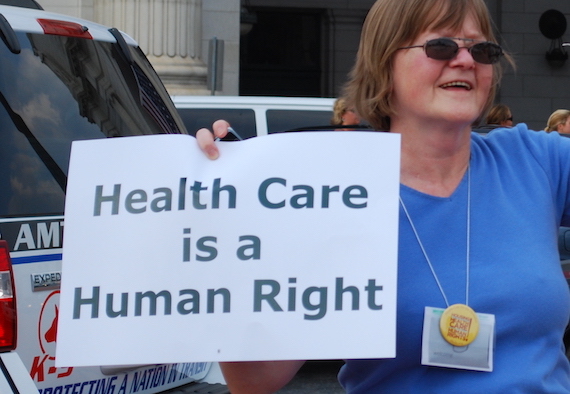Human rights practitioners spend considerable resources trying to raise awareness. This makes sense. How else are we to demand enjoyment of these rights if we don’t know we have them in the first place? Because rights awareness is so important for individual empowerment, civil society organizations and government agencies implement a wide variety of campaigns that disseminate information about human rights. Foundations and governments from the developed world fund and indirectly oversee local organizations abroad in their awareness-raising efforts. Even the United Nations created a World Programme for Human Rights Education. After all these efforts, do we know what makes for a good human rights awareness campaign?
One of the largest funders of awareness campaigns around the world, USAID, asked my research team that same question. In response, we surveyed the academic literature searching for answers and produced a literature review based on over 100 peer-reviewed articles and scholarly writings.
Flickr/NESRI/ (CC BY 2.0)
Disciplines from marketing to public health have long studied awareness campaigns and have much to say about differences in design and implementation strategies.
Disciplines from marketing to public health have long studied awareness campaigns and have much to say about differences in design and implementation strategies. However, evidence used in this research tends to come from campaigns in areas other than human rights. Academic research has not, for the most part, studied human rights awareness campaigns with the same rigour that we see in the case of anti-drug, cancer awareness, or election campaigns. Given this dearth of knowledge about the effectiveness of human rights awareness campaigns, our goal was to distill a series of field-relevant recommendations for designing successful awareness campaigns in the area of human rights from this research.
First, scholarly research generally agrees that framing is crucial. Frames organize reality by providing a specific interpretation of how an issue will be discussed. Within human rights campaigns, frames serve to: 1) define the problem; 2) suggest possible remedies; and, most importantly, 3) motivate society to engage. Campaigns that integrate these three framing functions, while being articulate and sensitive to local contexts, tend to be the most effective.
Second, because framing is so important, counter-framing is a real danger that needs to be anticipated. When adversaries to campaign goals put forward alternative frames, this complicates the framing strategies adopted by human rights practitioners. Counter-frames provide competing narratives about the same rights issue but are geared towards reaffirming the status quo, accusing campaigners of ulterior motives, or deflecting responsibility. The take-away for human rights advocates is that they should select frames that both consider the particularities of the target audience and make it difficult for opposing actors to invalidate the message. Ensuring that the frame comes from a credible source is one way to prepare for potential counter-framing.
Third, media is a powerful tool. Traditional mass media—television, radio, and newspapers—directly informs public opinion regarding human rights issues, but this requires a significant level of coverage. For this reason, it is key that human rights organizations maintain well-oiled relations with media actors. That being said, large media organizations can sometimes have editorial concerns or political inclinations that make them unlikely to broadcast the message of human rights campaigns. In such cases, alternative media channels might prove more effective and campaigners may need to get creative.
Some human rights organizations use theatre or enlist the help of comedians. The value of entertainment-based campaigns is that they resolve a central dilemma for campaign designers: how to present situations and characters that people can identify with, while also presenting a unique perspective on the issue in question. Another upside to entertainment-based campaigns is that they can be disseminated more widely, unlike documentaries that reach mostly those pre-disposed to the campaign message.
"The internet is not necessarily a more democratic space that accepts everyone’s voice equally."
Fourth, social media platforms provide novel venues for human rights campaigns. However, the Internet is not necessarily a more democratic space that accepts everyone’s voice equally. Thus, these new forms of activism and awareness raising (such as changing profile pictures to memes—an activity often referred to as “slacktivism”) should be used in conjunction with other forms of awareness raising. Some of these additional forms of awareness raising include the use of messaging applications such as Telegram and WhatsApp (for example, see here and here).
Fifth, research suggests that pre-testing techniques tend to increase a campaign’s chance of effectiveness. This evidence comes mostly from non-human rights areas: advertising and public health campaigns frequently employ pre-testing, while less well-funded human rights campaigns tend not to. However, our research does suggest that this is a crucial stage in campaign design that requires more focused energy and resources. Pre-testing can range from pilot campaigns, focus groups, surveys, online surveys, or even more informal conversations with individuals from the target group. Colorado’s POWER Campaign exemplifies the use of a variety of these pre-testing techniques.
In the same way that implementers should not assume that simply providing information will magically solve human rights problems, we do not assume that our recommendations are silver bullets against ineffective campaigns. Many of our findings are likely not new to practitioners, just very costly to implement. Our ultimate goal is that when campaign budgets are being drafted, those in the room making the case for preparatory work draw from the wealth of academic research that demonstrates the importance and effectiveness of specific framing and media campaign strategies.

